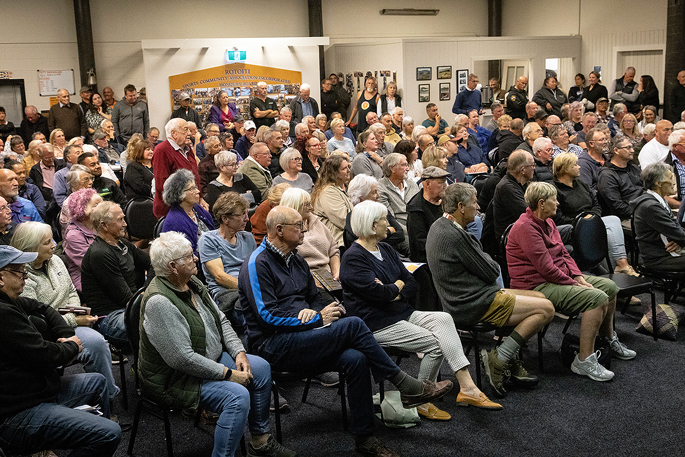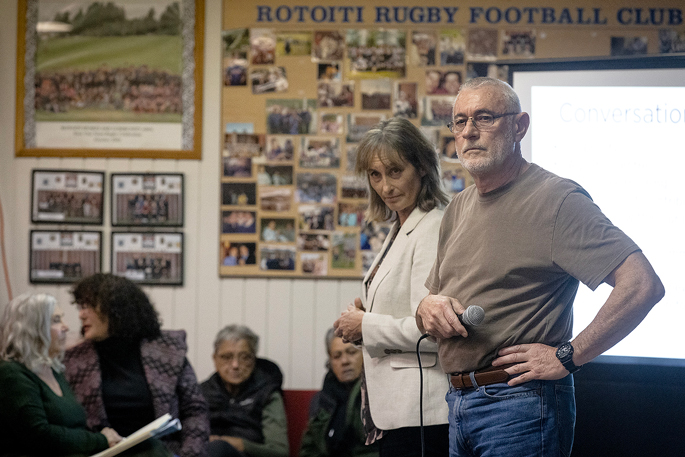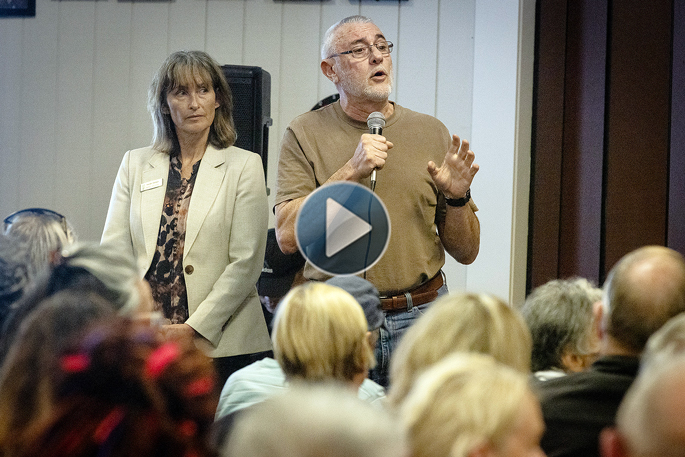Lakeside homeowners are furious about a “horrendous blowout” as they face paying up to about $88,000 per property to be connected to a sewerage scheme – up from at least $14,000 a few years ago.
Accusations of project mismanagement and lies were levelled at Rotorua Lakes Council during a fiery community meeting on Monday evening.
Through interruptions, a council manager maintained no final price had been provided for the East Rotoiti Rotomā Sewerage Scheme and cost increases were due to inflation, delays and resource consent compliance.
The Rotorua Daily Post reported in 2018 the estimated capital costs for each property were $14,000 to $15,000, which ratepayers would be able to pay upfront, or over 25 years totalling nearly $25,000 after interest.
There was standing room only as about 200 people filed into the Rotoiti Sports Club.
The consultation meeting on the draft Long-term Plan 2024-2034 was dominated by discussion of the $56.2 million (excluding GST) sewerage project.
Residents learned via letter three weeks ago the project was now expected to cost them about $30,000.
But if the council did not secure a $10m Government loan for the project it would cost the 770 lakeside residents $45,000 (including GST) in a lump sum, or about $88,000 if paid back via rates over 25 years from July.
The loan and an inflation adjustment for the council contribution would be paid back by all Rotorua ratepayers via the Lakes Enhancement rate.
Rural ward councillor Karen Barker attempted to open the meeting with information about the draft plan but was quickly drowned out by audience outcry about the sewerage scheme.
A real estate agent told the meeting vendors had been impacted hugely by the scheme.
“Deals are falling over left, right and centre.”
 Rotorua Lakes Council long term plan community meeting at the Rotoiti Sports Club. Photo / Andrew Warner.
Rotorua Lakes Council long term plan community meeting at the Rotoiti Sports Club. Photo / Andrew Warner.
One audience member said the $14,000 to $16,000 figure they were provided around 2017 was the reason they agreed to the scheme, fearing a lack of affordability if it was higher.
Another claimed the community was told in a 2018 public meeting it would “absolutely, conclusively be $14,000″ and in their view, “we’ve been misled”.
They called it a fair-trading issue.
Claims the community had been lied to were made on several occasions, while others called for the “horrendous blowout” to be covered by the council.
Infrastructure and environment general manager Stavros Michael attempted to answer a few questions, asking for a few uninterrupted minutes.
“It is a little unfortunate you didn’t let elected members talk about the Long-term Plan”, he began, but was cut-off by the audience.
“You are trying to put us in incredible debt … that is our long-term plan,” one called.
Michael said he heard and understood them but did not necessarily agree.
He said the scheme was formed on a 2014 proposal by a community reference group. The 2017 cost estimate was based on this.
 Rotorua Lakes Councillor Karen Barker and infrastructure and environment general manager Stavros Michael at a community hui in Rotoiti. Photo / Andrew Warner.
Rotorua Lakes Councillor Karen Barker and infrastructure and environment general manager Stavros Michael at a community hui in Rotoiti. Photo / Andrew Warner.
The scheme arose after Bay of Plenty Regional Council declared the lakeside areas to be maintenance zones and that residents needed to move away from using septic tanks to limit water quality impacts.
He said the type of system initially planned – grinder pumps – changed after resource consent hearings. Consent was issued for a treatment plant plus septic tank effluent pumping systems for Rotomā properties and Biolytix systems in Rotoiti.
Rotomā system installation work began in 2020 and at Rotoiti it began in 2022.
Michael said the change increased costs, along with timeline impacts of Covid-19 and high lake levels plus $9.7m in inflation.
“I don’t think we gave you a fixed price for anything.”
Consultation on the plan asked for feedback on the council contribution, he said. “What do you think, should there be more? That is what consultation is for.”
Some in the room voiced disbelief at his cost increase explanation, including the inflation addition. One resident claimed the original cost was based on the systems installed, not grinder pumps.
Councillor Robert Lee told the hui seven of 10 councillors were new and inherited the project so it was hard to answer some questions.
He suggested the regional council should contribute more than its $8.6m.
Barker said she took the community’s comments on board.
Claims of project mismanagement were also levelled during the meeting.
In one person’s view: “No one else in the real world gets away with this sort of incompetence.”
 Rotoiti resident Kepa Morgan speaks at a community hui on the council's draft Long-Term Plan. Photo / Andrew Warner.
Rotoiti resident Kepa Morgan speaks at a community hui on the council's draft Long-Term Plan. Photo / Andrew Warner.
Resident Kepa Morgan said in his opinion: “I have seen incompetent mismanagement.”
Morgan, who was a chartered engineer in wastewater engineering, called for an Ombudsman audit into the project.
‘Challenging and complicated’
Local Democracy Reporting asked for further comment from Michael after the meeting, including a response to residents’ concerns.
“Sewerage reticulation projects are challenging and complicated and we acknowledge the community’s concerns regarding cost,” he said.
The council communicated on cost changes as well as it could, he said, and the draft plan aimed to compress final costs as much as possible.
Michael said the council’s funding policy required communities benefiting from schemes to carry the net cost, minus external funding, under a capital-targeted rate.
Initial estimates were provided but the final cost was not known until completion.
“This project has complied with the regulatory framework set by resource consent conditions and we have endeavoured to satisfy technical requirements as well as Cultural Management Plan objectives and the terms of mana whenua land agreements.”
He said all project aspects were awarded through open competitive tenders.
Potential $56.21m scheme funding
Figures are GST exclusive.
$11.5m - Ministry for the Environment
$4.46m - Ministry of Health
$8.61m - Bay of Plenty Regional Council
$1.15m - Rotorua Lakes Council
$30.48m - Rotoiti and Rotomā ratepayers.
LDR is local body journalism co-funded by RNZ and NZ On Air.




0 comments
Leave a Comment
You must be logged in to make a comment.